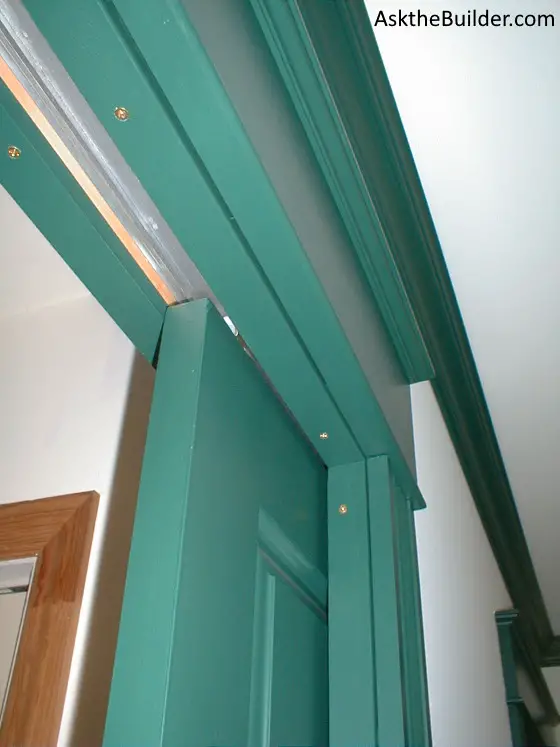Installing Pocket Doors

Installing Pocket Doors | Note the very important screws on the jambs. These allow you to access the door rollers.
DEAR TIM: I have a large archway between my home office and my dining room. I need to close off my office occasionally but do not want traditional swinging doors. I love pocket doors and want to add them. How much of a project is it to add these doors? Would the walls have to be completely torn out on either side of the opening to do the job? Karma T., Yulee, FL
DEAR KARMA: Pockets doors, in my opinion, are one of the top ten most overlooked items when many architects and builders plan a home. Even I underused this wonderful door option in my own home. If I had the chance to rebuild my home today, there are a minimum of 10 other rooms that would have pocket doors instead of the current swinging doors.
Why are pocket doors so wonderful?
Pocket doors are wonderful for many reasons, but I love the fact that they disappear into a wall. You can pick up an average of ten square feet of floor space when you use a pocket door instead of a traditional hinged swinging door. Modern high-quality pocket door hardware and frames allow these doors to remain trouble free for the life of the home.
Are pocket doors easy to install?
Pocket doors are easily added to a new home or one being remodeled, but installing one or two in an existing home is a little bit of work. Several years ago, I added a pocket door in my own home to separate the breakfast room from a hallway leading to our laundry room. My family and I endured the mess, but the final result has made everyone happy.
I had to do some demolition work to create the opening for my pocket door. You are correct in assuming that each side of your opening will have to be demolished since you want two pocket doors that will meet in the middle of the archway. The amount of wall space that needs to be opened up to create the pocket hideaway for each door is slightly greater than the overall width of each of the pocket doors.
Before starting installation, what is behind that wall?
But before you start swinging a sledgehammer or pounding a pry bar behind the existing trim, slow down and investigate what might be behind and above the wall. There can be all sorts of surprises behind the plaster, drywall or paneling. Plumbing waterlines and drain pipes, heating and cooling ducts, pipes and low voltage cables, and all sorts of electric and communication cables can be living comfortably where you want the pockets to take up residence. This is not to say all of these things can't be relocated, you simply should investigate and see what might be in your way.
Would you like to buy the exact pocket door frame I have in my own home? You know, the pocket door frames that are perhaps the best in the world? All you have to do is Click Here for Tim's Favorite Pocket Door Frame!

This pocket door was installed in Tim's house.
The underside and top of walls often yield clues as to what is inside of them. If you can see pipes, cables, ducts and other things that extend from a floor up or down into the wall cavity, then you will undoubtedly have some extra work ahead of you to accomplish your goal. Rest assured though it will be worth it in the long run.
Furthermore, the wall might be a bearing wall. While this is a significant challenge, it is often possible to install a large beam over the opening that will carry the load above and transfer it just beyond the reach of the pockets.
What are the best type of pocket door frames?
For years of trouble-free life, be sure to get the absolute best pocket door frames. Look for ones that have metal wrapped studs that will not warp. The wheeled trucks that latch to the door and ride back and forth in the track must be ones that cannot jump out of the track. Certain pocket door frames and hardware come with this guarantee.
Be sure the rough opening is square and plumb and the top of the rough opening is absolutely level. This will ensure that the pocket doors will glide smoothly in and out of the pockets and that the doors will meet perfectly when they are closed.
It is vitally important that the rough opening is perfect before the pocket door frames are installed. The last vertical studs that create the opening can be plumb but the overall opening can be twisted or in a helix. If this happens, the doors will never meet properly or they might rub when they are slid back into the pockets.
To ensure the rough opening is perfect and not twisted, extend strings diagonally from opposite corners on one side of the opening to create a giant letter X. If the strings just touch each other the opening is perfect and in the same plane. If there is a gap greater than one eighth inch between the strings, you need to adjust one or both of the vertical studs that create the large rough opening. Once the opening is confirmed to be in the same plane and not twisted, you can install the pocket door frames.
Column 489